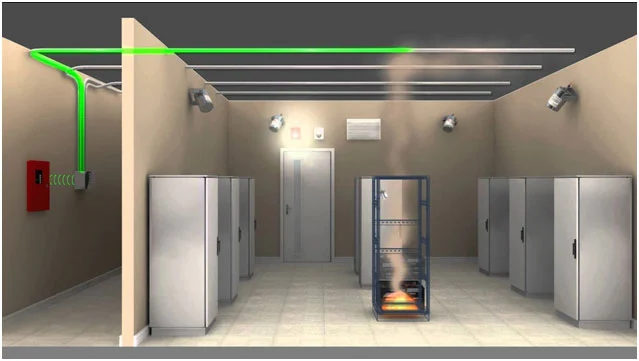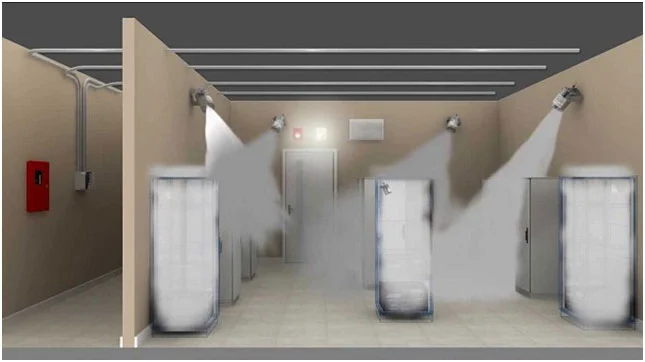(a) Three potential methods of action
(b) Aerosol generation
(c) Aerosol distribution
-
- The principle of the extinguishing action employed by aerosol is unique – a special solid chemical, which when electrically or thermally ignited, produces combustion byproducts – micron sized dry particles, (mainly potassium
carbonates), and a gaseous mixture, (mainly carbon dioxide, nitrogen and water vapour), mixed together into a uniform fire extinguishing aerosol, before being released into the protected area. The hot aerosol propels itself through a unique solid chemical coolant, which decomposes, absorbing huge amounts of heat, thus ensuring a flameless discharge and a uniform distribution of the cool aerosol within the area. The high rate of aerosol discharge ensures a tremendous knock down effect. Micron sized aerosol particles exhibit gas-like three-dimensional qualities that allow the agent to rapidly distribute throughout enclosure and to reach even the most concealed and shielded locations. Homogenous distribution is achieved in a matter of seconds, while long holding times all help to prevent fire re-ignition.
When activated the solid aerosol element undergoes a combustion reaction, which can schematically be represented as follows:
-
- KNO3 (s) + CnHmNpOq (s) = KHCO3 (s) + K2CO3 (s) + CO2 (g) + N2(g) + H2O (g)
- Combustion products mainly consist of potassium carbonates (KHCO3 , K2CO3), carbon dioxide gas (CO2 (g)), nitrogen gas ( N2 (g) ) and water vapour (H2O(g)) and represent the actual extinguishing agent.
- As the reaction temperatures are high, potassium carbonates are formed in the gas phase, but as the vapors cools, the potassium carbonates condense to a liquid and then a solid. As solid potassium carbonates are produced by condensation, the particle size is very small – approximately from 1 to 10 microns. Micron sized solid particles mix with the gaseous carbon dioxide, nitrogen and water into a uniform homogeneous gas-like phase – an aerosol.
- Thus, extinguishing aerosol is a suspension of the micron sized solid particles, mainly potassium carbonates, in the gas mix of carbon dioxide, nitrogen and water vapor.
Aerosols may be used as a fixed fire suppressant system in total flooding (prime application) and localapplications to fight fires of classes A, B, C, E and F. For class C fires consideration should be given tothe use of vapour detection, explosion venting or explosion suppression systems where an explosionpotential may exist, owing to the possible presence of gaseous, volatile or atomized fuels eitherbefore or following a fire. It may be dangerous, under certain conditions to extinguish a burning jet offlammable gases without first shutting off its supply. The design application density required tosuppress normal fires involving flammable gases and liquids at atmospheric pressure shall apply if itcan be shown that a potentially explosive atmosphere cannot exist in the enclosure either before or as a result of the fire.




